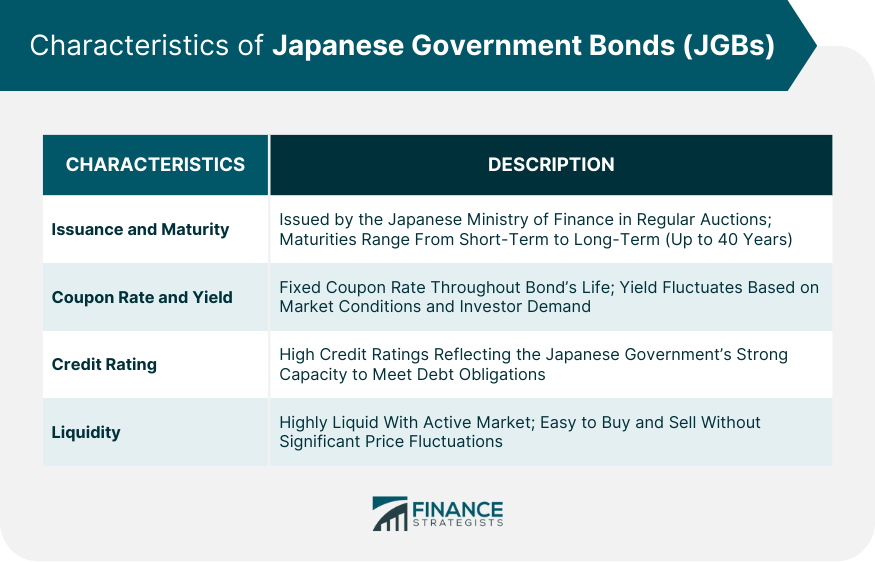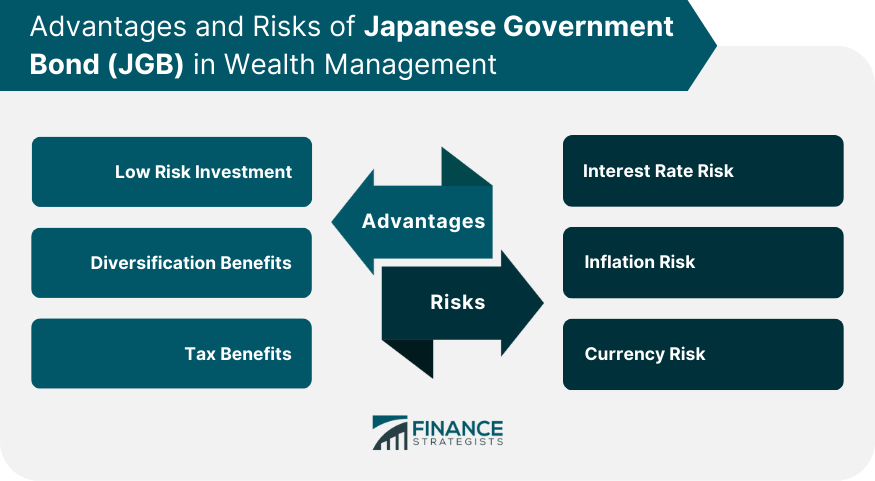Japanese Government Bonds are debt securities issued by the government of Japan to finance budget deficits and public projects. Denominated in yen, they serve as a vital funding source. Investors buy JGBs for interest income and capital preservation. With various maturities and interest rates determined by market conditions, JGBs are seen as a safe investment due to the Japanese government's creditworthiness. JGBs play a significant role in wealth management, providing stability, low risk, income, and portfolio diversification for both individual and institutional investors. They serve as benchmarks for other fixed-income securities and indicate the Japanese economy's health. JGBs also act as a hedge against market volatility and a safe haven in uncertain times. Incorporating JGBs in wealth management strategies enhances risk-return profiles and helps achieve long-term financial goals. JGBs are issued by the Ministry of Finance of Japan through regular auctions, typically held monthly or quarterly, depending on the type of bond. The maturities of JGBs range from short-term Treasury bills with maturities of less than one year to long-term bonds with maturities of up to 40 years. The issuance of JGBs follows a predetermined schedule, allowing investors to plan their investment strategies accordingly. The Japanese government also offers inflation-linked bonds, which adjust their principal and interest payments based on changes in the consumer price index. JGBs pay interest to investors in the form of a coupon, which is a fixed percentage of the bond's face value. The coupon rate is determined at the time of issuance and remains constant throughout the life of the bond. JGB yields, on the other hand, represent the return on investment for the bondholder and fluctuate based on market conditions and investor demand. As with other fixed-income securities, there is an inverse relationship between bond prices and yields. When bond prices rise, yields fall, and vice versa. The yield on JGBs can be influenced by factors such as economic growth, inflation expectations, and monetary policy decisions by the Bank of Japan. The credit rating of JGBs is a measure of the creditworthiness of the Japanese government and its ability to meet its debt obligations. Credit rating agencies, such as Moody's, Standard & Poor's, and Fitch, assign ratings to JGBs based on their assessment of the Japanese government's financial stability and economic outlook. JGBs generally have high credit ratings, reflecting the Japanese government's strong capacity to service its debt. However, credit ratings can change over time in response to shifts in the government's fiscal position or changes in the economic environment. Investors should monitor credit ratings when assessing the risk profile of JGBs. JGBs are highly liquid financial instruments, meaning they can be easily bought and sold in the secondary market without causing significant price fluctuations. The liquidity of JGBs is supported by the deep and active market for Japanese government debt, with a large and diverse investor base, including domestic and international institutions, as well as individual investors. This high level of liquidity enables investors to enter and exit positions in JGBs with ease, providing flexibility in managing their portfolios. Moreover, the liquid market for JGBs contributes to transparent pricing and efficient price discovery, allowing investors to make well-informed investment decisions. JGBs are considered low-risk investments due to the creditworthiness of the Japanese government and the stable economic environment in Japan. The Japanese government has a strong track record of meeting its debt obligations, and the country's robust financial system further supports the safety of JGBs as an investment. For investors seeking a conservative investment option with predictable income, JGBs can be an attractive choice. The low-risk nature of JGBs makes them suitable for conservative investors or those nearing retirement who want to preserve their capital. Incorporating JGBs into an investment portfolio can provide diversification benefits, as they tend to exhibit low correlation with other asset classes, such as equities and commodities. This means that JGBs can help to reduce the overall risk of a portfolio and improve its risk-adjusted returns. Diversification is a crucial aspect of wealth management, as it helps to spread risk across different investments and minimize the impact of market fluctuations on portfolio performance. By investing in JGBs, investors can achieve better diversification and enhance the stability of their investment portfolios. Japanese government bonds offer certain tax benefits for investors, which can enhance their overall returns. For example, interest income from JGBs is exempt from local and prefectural income taxes in Japan. In addition, non-resident investors may be eligible for tax exemptions on interest income from JGBs under certain conditions. These tax advantages can make JGBs more attractive to investors seeking tax-efficient investment options. However, investors should consult with a tax services professional to understand the specific tax implications of investing in JGBs based on their individual circumstances. As with all fixed-income securities, JGBs are subject to interest rate risk. When interest rates rise, bond prices tend to fall, resulting in capital losses for bondholders. Conversely, when interest rates decline, bond prices increase, leading to capital gains. Investors should be aware of the interest rate risk associated with JGBs, as it can affect the market value of their investments. To manage this risk, investors can consider diversifying their bond holdings across different maturities or employing strategies, such as laddering, to mitigate the impact of interest rate fluctuations. Inflation risk is the potential for the purchasing power of an investment to erode over time due to rising prices. As JGBs pay fixed interest payments, they can be vulnerable to inflation risk if the rate of inflation exceeds the bond's yield. Investors concerned about inflation risk can consider investing in inflation-linked JGBs, which adjust their principal and interest payments based on changes in the consumer price index. This can help to preserve the real value of their investments and provide a hedge against inflation. For non-resident investors, currency risk is an important consideration when investing in JGBs. Fluctuations in the exchange rate between the investor's home currency and the Japanese yen can impact the returns on JGB investments when converted back to the investor's home currency. To mitigate currency risk, investors can consider using currency hedging strategies, such as forward contracts or currency options, to minimize the impact of exchange rate fluctuations on their JGB investments. The buy and hold strategy involves purchasing JGBs and holding them until maturity. This approach can be suitable for conservative investors seeking predictable income and capital preservation. By holding JGBs to maturity, investors can lock in a fixed rate of return and avoid the impact of interest rate fluctuations on the market value of their investments. The buy and hold strategy can be particularly effective for long-term investors who have a well-defined investment horizon and do not require frequent access to their invested capital. However, this approach may not be suitable for investors seeking capital appreciation or those who may need to liquidate their investments before maturity. The ladder strategy for investing in Japanese government bonds involves spreading your investments across bonds with different maturities. Start by purchasing bonds with varying terms, such as 1, 3, 5, and 10 years. As each bond matures, reinvest the proceeds into a new bond with the longest remaining term. This approach ensures a continuous flow of bond maturity and potentially maximizes yield while managing interest rate risk. Maintain the ladder by periodically reinvesting maturing bonds into longer-term options. Regularly reassess your investment goals and market conditions to adjust the ladder structure as needed. The barbell strategy involves investing in JGBs with both short-term and long-term maturities while avoiding intermediate-term bonds. This approach creates a portfolio with bonds concentrated at the two ends of the maturity spectrum, resembling a barbell shape. To implement it in Japanese government bonds, allocate a portion of the investment to short-term bonds (e.g., 1-2 years maturity) and another portion to long-term bonds (e.g., 10-30 years maturity). This strategy aims to benefit from the stability and liquidity of short-term bonds, while taking advantage of higher yields offered by long-term bonds. By avoiding intermediate-term bonds, investors can reduce interest rate risk. Regular rebalancing is essential to maintain the desired allocation and manage risk exposure. JGBs are debt securities issued by the Japanese government to finance its budget deficits and public projects. They serve as an essential source of funding for the government and offer a low-risk investment option for investors seeking to preserve capital and generate income. Key characteristics of JGBs include their issuance and maturity, coupon rate and yield, credit rating, and liquidity. Understanding these characteristics is crucial for investors when assessing the suitability of JGBs for their investment portfolios. JGBs offer several advantages in wealth management, such as low-risk investment, diversification benefits, and tax benefits. However, they also come with risks, including interest rate risk, inflation risk, and currency risk. Investors should carefully evaluate the advantages and risks of JGBs to determine their appropriate role in their investment portfolios. Investors can employ various strategies when investing in JGBs, including the buy and hold strategy, ladder strategy, and barbell strategy. Each strategy has its unique benefits and considerations, and investors should choose the approach that best aligns with their investment objectives, risk tolerance, and time horizon. By understanding the characteristics, advantages, risks, and investment strategies associated with JGBs, investors can make informed decisions and tailor their wealth management strategies to achieve their financial goals.Definition of Japanese Government Bonds (JGBs)
Characteristics of JGBs
Issuance and Maturity
Coupon Rate and Yield
Credit Rating
Liquidity

Advantages of JGB in Wealth Management
Low-Risk Investment
Diversification Benefits
Tax Benefits
Risks of JGB in Wealth Management
Interest Rate Risk
Inflation Risk
Currency Risk

Strategies for Investing in JGB
Buy and Hold Strategy
Ladder Strategy
Barbell Strategy
Final Thoughts
Japanese Government Bond (JGB) FAQs
Japanese Government Bond (JGB) is a debt instrument issued by the Japanese government to finance its budget deficits and meet financial obligations.
JGBs are considered a low-risk investment with stable returns, providing diversification benefits to an investor's portfolio. Additionally, JGBs offer tax benefits to investors.
JGBs are exposed to interest rate risk, inflation risk, and currency risk. If interest rates rise, bond prices fall, leading to losses for the investor.
JGBs have a high credit rating because they are backed by the Japanese government, which has a stable and robust economy.
Investors can adopt a buy and hold strategy, laddering strategy or barbell strategy to invest in JGBs. These strategies allow investors to balance risk and returns and maintain liquidity in their portfolio.
True Tamplin is a published author, public speaker, CEO of UpDigital, and founder of Finance Strategists.
True is a Certified Educator in Personal Finance (CEPF®), author of The Handy Financial Ratios Guide, a member of the Society for Advancing Business Editing and Writing, contributes to his financial education site, Finance Strategists, and has spoken to various financial communities such as the CFA Institute, as well as university students like his Alma mater, Biola University, where he received a bachelor of science in business and data analytics.
To learn more about True, visit his personal website or view his author profiles on Amazon, Nasdaq and Forbes.











